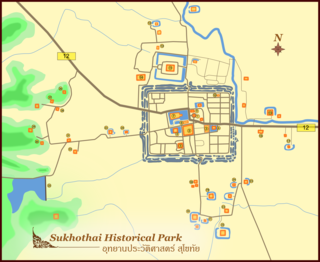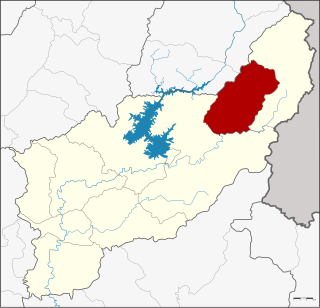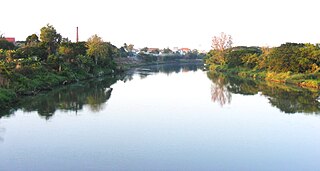
Wat Phra Kaew commonly known in English as the Temple of the Emerald Buddha and officially as Wat Phra Si Rattana Satsadaram, is regarded as the most sacred Buddhist temple (wat) in Thailand. The Emerald Buddha housed in the temple is a potent religio-political symbol and the palladium of Thailand. The temple is in Phra Nakhon District, the historic centre of Bangkok, within the precincts of the Grand Palace.

The Emerald Buddha is considered the palladium of the Kingdom of Thailand. It is a figurine of the meditating Buddha seated in yogic posture, made of a semi-precious green stone, clothed in gold, and about 26 inches (66 cm) tall. It is housed in the Temple of the Emerald Buddha on the grounds of the Grand Palace in Bangkok.

Sukhothai Historical Park covers the ruins of Sukhothai, literally 'dawn of happiness', capital of the Sukhothai Kingdom in the 13th and 14th centuries, in north central Thailand. It is near the city of Sukhothai, capital of Sukhothai Province.

Phichit is a province (changwat) of Thailand. It lies 330 km due north of Bangkok. Neighboring provinces are Phitsanulok, Phetchabun, Nakhon Sawan, and Kamphaeng Phet.

Wat Pho, also spelled Wat Po, is a Buddhist temple complex in the Phra Nakhon District, Bangkok, Thailand. It is located on Rattanakosin Island, directly south of the Grand Palace. Known also as the Temple of the Reclining Buddha, its official name is Wat Phra Chetuphon Wimon Mangkhalaram Rajwaramahawihan. The more commonly known name, Wat Pho, is a contraction of its older name Wat Photaram.

Wat Phra Kaew is a third-common-class royal temple situated in the area of 10,640 square metres on Trairat road, Wiang sub-district, Muang Chiang Rai in Chiang Rai City, Thailand. The King of Thailand upgraded the temple to the royal temple on May 31, 1978. The temple gains historical importance as the place where the Emerald Buddha was found. It is also one of the main centres of Buddhist education and the Sangha's administration in northern Thailand.

Phet Kasem Road or Thailand Route 4 is one of the four major highways in Thailand, along with Phahonyothin Road, Mittraphap Road, and Sukhumvit Road. At 1,274 km, it is the longest highway in Thailand. It begins at Naowa Chamnian bridge in Bangkok Yai, Bangkok. It is named after Luang Phet Kasemwithisawasdi, the seventh director general of the Department of Highways.

Fak Tha is a district (amphoe) of Uttaradit Province, northern Thailand.

Dhammakaya meditation is a method of Buddhist meditation developed and taught by the Thai meditation teacher Luang Pu Sodh Candasaro (1885–1959). In Thailand, it is known as vijjā dhammakāya, which translates as 'knowledge of the dhamma-body'. The Dhammakaya meditation method is popular in Thailand and some parts of Southeast Asia, and has been described as a revival of samatha (tranquility) meditation in Thailand.
Wat Bang Nom Kho is a Buddhist temple (Wat) in Sena district, Ayutthaya Province, Thailand. The temple was made famous by one of Thailand's Gaeji Ajarn high monks, Luang Pho Phan, who was renowned for his blowing of the sacred Diamond Armour Yantra, (or Yant, onto the forehead of his disciples. According to legend, many of these disciples, after death, were found to have an impression of the Yant mysteriously embedded into their skull. The Yant was allegedly revealed to Luang Pho Phan in a dream, which led him to its discovery on a metal template hidden within a Chedi. Luang Pho Phan was also reputed to have received the ability to make powder based amulets of Buddha images sitting on animals from a Chee Ba Khaw,. These amulets are extremely sought after and expensive due to their reputed powers.

Wat Intharawihan or Wat Intharavihan is a Third Class Royal wat (temple) located in the Phra Nakhon District of Bangkok, Thailand.. It is noted for its 32 metres (105 ft) high standing Buddha statue known as Luang Pho To or "Phra Si Ariyamettrai" that was erected on the inspiration of the still highly revered abbott Ajarn Toh.

A wat (Khmer: វត្ត wōat; Lao: ວັດ vat; Tai Lu: 「ᩅᨯ᩠ᨰ」(waD+Dha) or 「ᩅᨯ᩠ᨵ」(waD+dha); Tai Yuan: 「ᩅ᩠ᨯ᩶」(w+Da2); Thai: วัด, RTGS: wat, pronounced [wát]) is a type of Buddhist temple and Hindu temple in Cambodia, Laos, East Shan State, Yunnan and Thailand. The word wat is borrowed from Sanskrit vāṭa (Devanāgarī: वाट), meaning 'enclosure'.
This is a list of articles related to Thailand, sorted by alphabetical order. It represents the majority of articles contained within the Thailand category. For a list of key articles arranged by topic, see Outline of Thailand.

Uttaradit railway station is the main railway station for Uttaradit province. It is owned by the State Railway of Thailand and serves the Northern Line. Uttaradit railway station is located 485.17 kilometres (301.5 mi) from Bangkok railway station. It is also a Class 1 Station and is also the base for lots of maintenance subdivisions.

A Thai Buddha amulet, often referred to academically as "votive tablet", is a kind of Thai Buddhist blessed item. It is used to raise funds to help the temple producing the amulets. Worshippers can obtain an amulet or Thai Buddhist monk blessing by simply donating money or offering oil to the temple. After the donation, the monk will give them an amulet as a gift. The amulets no longer simply are considered a "gift", but a tool to help enhance luck in different aspects of life. People use amulets to improve their marriage, wealth, health, love and relationships.

Sanam Chai Road is a historic street in Bangkok's Phra Nakhon District. It continues from Ratchadamnoen Nai Road at the northeastern corner of the Grand Palace, and runs south to meet Rachini and Maharat roads near the mouth of the old city moat, a short distance of 1.1 kilometres (0.68 mi). The Grand Palace, Wat Pho, Museum Siam, and Phra Ratchawang Police Station are located on the west side of the road, while on the east side are the Ministry of Defence headquarters, Saranrom Palace, Saranrom Park, the Territorial Defense Command headquarters and Wat Rajabopit School. Sanam Chai Station of the underground MRT's under-construction Blue Line is located beneath the road's final stretch.

Wat Rai Khing is another prominent and notable temple in Nakhon Pathom Province in addition to Wat Phra Pathom Chedi, which is the provincial temple. Wat Rai Khing is located along the Tha Chin River, Tambon Rai Khing, Amphoe Sam Phran on Petchkasem Road, west of Bangkok. And not far from other attractions such as Sampran Riverside, Samphran Elephant Ground & Zoo etc.



















